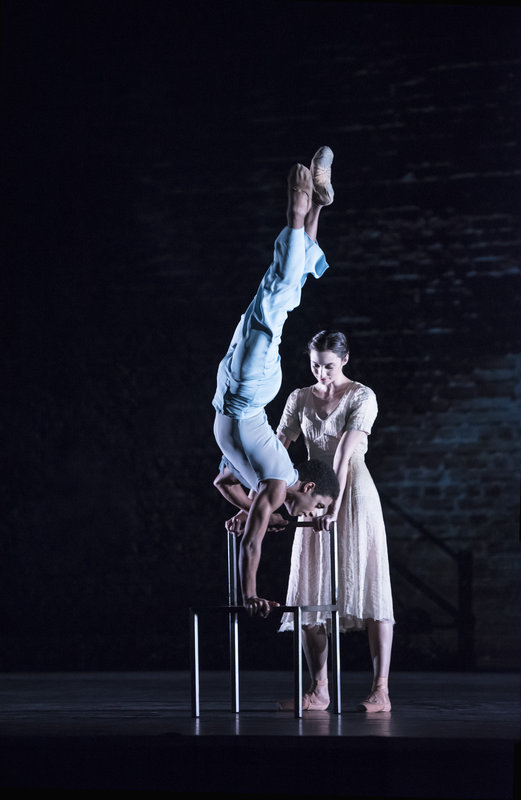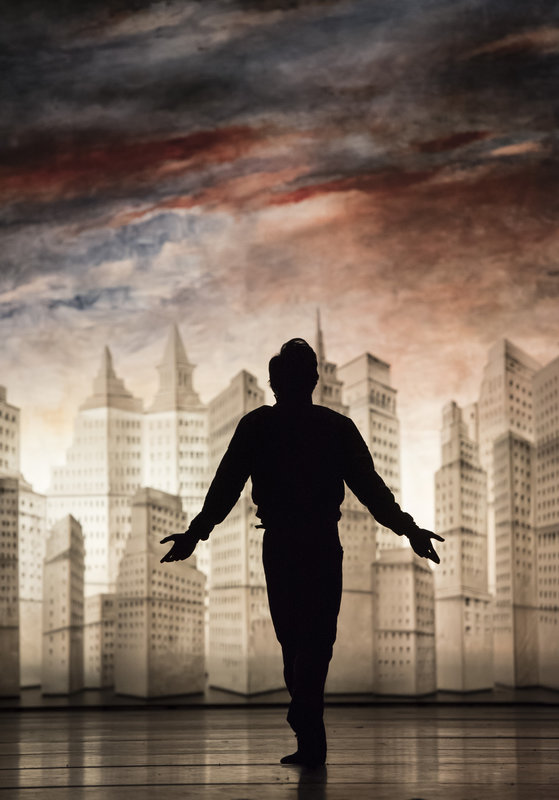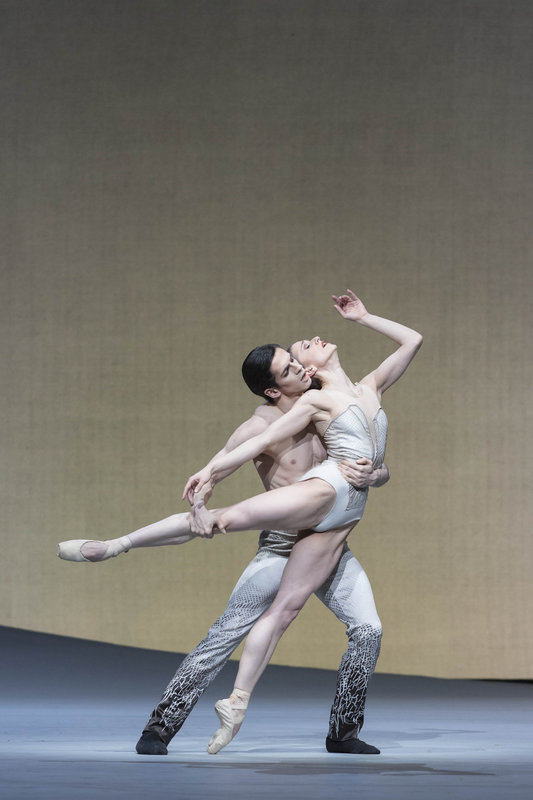English National Ballet and Birmingham Royal Ballet have staged programmes of war pieces already this year; now here's the Royal Ballet bringing up the rear in its own inimitable (and rather oblique) fashion with a triple bill that picks up on and subtly plays with the anxiety felt by those great British artists, Benjamin Britten and W.H. Auden, in the 1930s and 1940s.
 Brandstrup's Ceremony of Innocence, first performed at last year's Aldeburgh Festival and set to Britten's 1937 Variations on a Theme of Frank Bridge, promised much, but for my money didn't deliver. With a Britten score, a narrative of art, age and regret, and choreography from the likeable Dane behind the widely-praised dance sequences in ENO's Death in Venice, I was hoping for a refreshing antidote to the abstract, futuristic works that have been the Royal Ballet's one-act premières this year, but the great dramatic potential of the conceit (a Death-in-Venice-alike encounter between a mature artist and his remembered youthful self) is lost in the gloom of a dark set, and too little interesting dance material.
Brandstrup's Ceremony of Innocence, first performed at last year's Aldeburgh Festival and set to Britten's 1937 Variations on a Theme of Frank Bridge, promised much, but for my money didn't deliver. With a Britten score, a narrative of art, age and regret, and choreography from the likeable Dane behind the widely-praised dance sequences in ENO's Death in Venice, I was hoping for a refreshing antidote to the abstract, futuristic works that have been the Royal Ballet's one-act premières this year, but the great dramatic potential of the conceit (a Death-in-Venice-alike encounter between a mature artist and his remembered youthful self) is lost in the gloom of a dark set, and too little interesting dance material.
The astonishingly silky, elastic dancing of Marcelino Sambé, as the boyish incarnation of Edward Watson's artist, was a highlight, but the choreography for everyone else relied too much on a limited repertoire of turns and turning jumps or lifts (and even rather a lot of portentous walking). Christina Arestis (pictured above right with Marcelino Sambé) as the mother was stately and luscious as ever, and her tender moments with both Sambé and Watson among the more obvious emotional hooks of the piece. I liked the brisk dancing of Beatriz Stix-Brunell, Alexander Campbell, Romany Padjak and Johannes Stepanek as the supporting couples in a couple of waltz sections, but couldn't quite figure out what part they played in the story – nor could I see them properly. The lighting, coming low from the sides with patently insufficient wattage, made a beautiful feature of Edward Watson's rippling deltoids, but left the dancers' faces in darkness.
The design does not benefit, I suspect, from being transferred from the intimate space of Snape Maltings to the vast Covent Garden stage. The constantly moving digital backdrop must have served to create scenic depth and interest in a space too small for proper staging, but blown up to many times the dancers' height, it's both flat and overpowering when representing bricks or (why?) a grid of hexagons, and distracting when blood or ink starts to drip down the "brickwork"; I felt it added something only when it turned to the surging of the sea, which supplies a superb closing image.  Home-grown Royal Ballet choreographer Liam Scarlett wrings a poignant story from the fear of both war and modern anomie as expressed in Auden's 1947 poem The Age of Anxiety. Scarlett's piece of the same name (set to Leonard Bernstein's 1949 Symphony No. 2, itself inspired by Auden's poem) follows closely the external events of the poem, tracking the interactions of four characters in a New York bar in wartime. Four stupendous actor-dancers have the big job of carrying this 40-minute piece, and they are riveting in their roles – Laura Morera as Rosetta, Steven McRae as Emble, Bennet Gartside as Quant and Tristan Dyer as Malin. McRae is on fire as the mercurial young seaman, lithe, wiggly, posturing, flirting with men and women alike. There's more than a hint of Gene Kelly about McRae, and an obvious homage to Broadway in parts of the choreography, with Scarlett casually displaying his facility with fluid, feel-good movement particularly in a jazzy pas de quatre in Rosetta's apartment.
Home-grown Royal Ballet choreographer Liam Scarlett wrings a poignant story from the fear of both war and modern anomie as expressed in Auden's 1947 poem The Age of Anxiety. Scarlett's piece of the same name (set to Leonard Bernstein's 1949 Symphony No. 2, itself inspired by Auden's poem) follows closely the external events of the poem, tracking the interactions of four characters in a New York bar in wartime. Four stupendous actor-dancers have the big job of carrying this 40-minute piece, and they are riveting in their roles – Laura Morera as Rosetta, Steven McRae as Emble, Bennet Gartside as Quant and Tristan Dyer as Malin. McRae is on fire as the mercurial young seaman, lithe, wiggly, posturing, flirting with men and women alike. There's more than a hint of Gene Kelly about McRae, and an obvious homage to Broadway in parts of the choreography, with Scarlett casually displaying his facility with fluid, feel-good movement particularly in a jazzy pas de quatre in Rosetta's apartment.
It's in this second half, after the group has left the bar, that Scarlett and his dancers begin to wring the best out of the story: mining dramatic gold from the awkward but tender late night togetherness of the strangers who have become temporary friends much more effectively than they do from the earlier imagined journey sequences. Dyer and Gartside, who in the bar were effaced both by dim lighting and by the McRae-Morera chemistry, come into their own with a series of nuanced, tender, even surprising interactions. It's only a pity that the splendid ambiguity that follows the party's close – with Morera at first joyful on her own, then suddenly frantic and tense with anxiety – is spoiled rather by a dreadfully long ending in which Tristan Dyer must dance against a radiant NYC skyscape (pictured above left) while Bernstein's otherwise rewarding score goes into Beethoven-worthy death agonies.  Christopher Wheeldon's Aeternum, set to Britten's 1940 Sinfonia da Requiem, here receives its first revival, having premièred at the Opera House eighteen months ago. I remembered it chiefly for its remarkable set – a huge collage of bleached, driftwood-like sticks, which floats up gradually throughout the piece, eventually to disappear into the heavens – and the interesting shapes of its first minutes, which see the women of the corps do a striking, leggy crawl towards Marianela Nuñez's frail, isolated central figure. I was glad to rediscover the fizzing second movement, in which James Hay delivered a virtuosic performance, but otherwise not much more taken with Aeternum on second viewing. While the dance is mostly rendered with Wheeldon's habitual elegance, there are some howlers too (Nuñez bending over backwards while Federico Bonelli hangs onto her feet like a fisherman hauling in lobster creels), and no real sense of heart in either the mourning or the redemption of its requiem.
Christopher Wheeldon's Aeternum, set to Britten's 1940 Sinfonia da Requiem, here receives its first revival, having premièred at the Opera House eighteen months ago. I remembered it chiefly for its remarkable set – a huge collage of bleached, driftwood-like sticks, which floats up gradually throughout the piece, eventually to disappear into the heavens – and the interesting shapes of its first minutes, which see the women of the corps do a striking, leggy crawl towards Marianela Nuñez's frail, isolated central figure. I was glad to rediscover the fizzing second movement, in which James Hay delivered a virtuosic performance, but otherwise not much more taken with Aeternum on second viewing. While the dance is mostly rendered with Wheeldon's habitual elegance, there are some howlers too (Nuñez bending over backwards while Federico Bonelli hangs onto her feet like a fisherman hauling in lobster creels), and no real sense of heart in either the mourning or the redemption of its requiem.
It's cool and pretty, yes, and Nuñez (pictured above right with Bonelli) is lovely in anything she does, but Aeternum was too bloodless to drive the vibrant characters and fully-developed world of The Age of Anxiety, flaws and all, out of my head. Scarlett (and Dyer, Gartside, McRae & Morera), Bernstein and Auden are the major winners; Britten too takes a bow (though not always thanks to the ROH orchestra's slightly patchy playing), and the Royal Ballet's top dancers impress in a pleasingly original, if not uniformly, entertaining triple.
- See this triple bill at the Royal Opera House until 17 November














Add comment